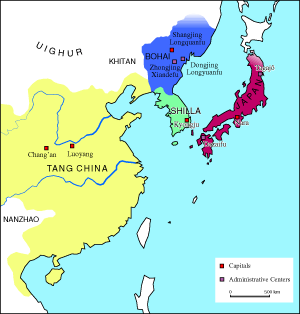 Clickable
Map of East Asian Historical Cities
Clickable
Map of East Asian Historical CitiesIn the 8th century, when Nara was the capital of Japan, China was at the height of its prosperity under the Tang Dynasty. International trade became active on an unprecedented scale, and a great quantity of exotic goods from the West were brought by way of the Silk Road to the capital Chang’an (today’s Xian). Dr. Edward Schafer, an Orientalist, mentioned many elements of exotic tastes which prevailed in Chinese society at the time. Under the power and advanced civilization of China, the East Asia region was reorganized to form the East Asian World. In the previous century, the Korean peninsula was unified by the Shilla Dynasty and Japan also formed its state.
The following text from Nihon-shoki (Chronicles of Japan compiled in the 8th century) refers to the report presented to the Japanese court of Empress Suiko by the students who had just returned from China in 623 AD.
| At this time, the Buddhist priests E-sai and E-ko, with the physicians E-jitsu and Fuku-in, students of the learning of Great Thang, arrived in company with Chi-syon-i and the others. Now E-jitsu and the rest made together a representation to the Empress, saying: — “Those who have resided in Thang for study have all completed their courses, and ought to be sent for. Moreover, the Land of Great Thang is an admirable country, whose laws are complete and fixed. Constant communication should be kept up with it.” |
— Nihongi translated
by W. G. Aston, p. 150. |
The Bohai (Balhae in Korean) State was also formed by the Tungusic people at the end of the 7th century in the northeastern part of today’s China. These states shared aspects of Chinese culture such as the writing system, legal system and Confucian ethics. Buddhism, based on scriptures translated into Chinese, was another shared cultural feature. Nonetheless, they still maintained their native culture. Therefore, in the East Asia region, writing systems based on Chinese characters continue to be used to express different languages today.
October 11, 2004, newspapers reported that Chinese researchers announced the existence of a stone epitaph for a Japanese student who died of a sudden illness in 734 AD and was buried in the suburbs of Chang’an. The epitaph had been unearthed at a construction site and obtained by the Northwest University in Xian. The name of the buried person was Jing Zhencheng who cannot be identified by Japanese records. As for his family name Jing, scholars consider that it suggested his Japanese name, possibly Fujii or Inoue. The epitaph states that the emperor (Xuanzong of the Tang Dynasty) mourned his death and conferred him a court rank. The epitaph concludes with the following words. “Although his body has been buried in foreign land, his soul would go back home.” The discovery gave us a glimpse of a small episode which occurred in the context of international exchange among East Asian states in the 8th century.
The Chinese system of city planning was also shared by the East Asian states of the time. They modeled their capital after China’s capital of Chang’an. The features of this system included a rectangular shape, grid patterns for streets and city blocks, and location of the palace site in the center of the city’s north side. Examples of this system can be seen at Kyongju of Shilla (Korea), Nara and Kyoto of Japan, and Shangjing Longquanfu of the Bohai State located at Ning’an, Heilongjiang Province of modern China. The last one is a precious example that preserves the Chang’an style of city planning.
By Noboru Ogata, Emeritus, Kyoto University